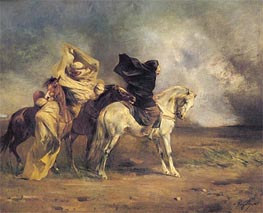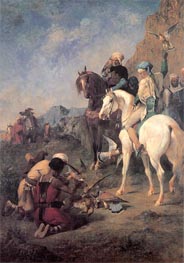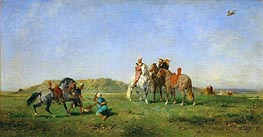
Eugene Fromentin Painting Reproductions 1 of 1
1820-1876
French Academic Classicism Painter
Eugène Fromentin (1820–1876) stands as a unique figure in 19th-century French art, seamlessly bridging the worlds of painting and literature. Born on October 24, 1820, in La Rochelle, he initially trained under the landscape painter Louis Cabat. Early in his career, Fromentin's work exhibited a certain stiffness, but this gradually gave way as he fell under the successive influences of Jean-Baptiste-Camille Corot and Eugène Delacroix.
Delacroix's vibrant use of color deeply impacted Fromentin, transforming him into a brilliant colourist. This evolution is vividly apparent in works like "Arab Falconer" (1863), "La Chasse au héron" (1865), and "Souvenir d’Ezneh, Haute-Egypte" (1876). These paintings not only capture the exotic landscapes of Algeria and Egypt but also reflect a profound engagement with light and movement.
Fromentin was among the earliest artists to depict Algeria's land and people with such intimacy. His journeys to North Africa began when he was quite young, allowing him to immerse himself in its culture and scenery. This firsthand experience lent his artwork an authenticity that resonated with audiences back in France. His depictions weren't mere romanticized visions; they were observant portrayals that bridged two worlds.
But Fromentin's talents weren't confined to the canvas. He was equally adept with the pen, and some argue his literary contributions surpass his artistic ones. His novel "Dominique," published in 1862 and dedicated to George Sand, is a remarkable exploration of introspection and emotion, standing out amid the literature of the time. His travel writings, such as "Un Été dans le Sahara" (1857) and "Une Année dans le Sahel" (1858), offer rich, descriptive narratives that transport readers to the very heart of the Sahara.
Perhaps his most influential literary work is "Les Maîtres d’autrefois" (1876), where Fromentin examines the masterpieces of Belgian and Dutch painters. His insights into artists like Rubens and Rembrandt are not just scholarly critiques but personal reflections from one artist to another. This approach provides a nuanced perspective that was quite innovative for his time. The esteemed art historian Bernhard Berenson praised the book, noting that Fromentin was "the only writer on pictures worth his salt."
Eugène Fromentin passed away on August 27, 1876, in his native La Rochelle. His dual legacy as a painter and writer leaves a lasting impression on both the art and literary worlds. Fromentin's ability to capture the essence of a place - whether through vivid brushstrokes or eloquent prose - continues to inspire and influence, reminding us of the enduring power of cross-disciplinary creativity.
Delacroix's vibrant use of color deeply impacted Fromentin, transforming him into a brilliant colourist. This evolution is vividly apparent in works like "Arab Falconer" (1863), "La Chasse au héron" (1865), and "Souvenir d’Ezneh, Haute-Egypte" (1876). These paintings not only capture the exotic landscapes of Algeria and Egypt but also reflect a profound engagement with light and movement.
Fromentin was among the earliest artists to depict Algeria's land and people with such intimacy. His journeys to North Africa began when he was quite young, allowing him to immerse himself in its culture and scenery. This firsthand experience lent his artwork an authenticity that resonated with audiences back in France. His depictions weren't mere romanticized visions; they were observant portrayals that bridged two worlds.
But Fromentin's talents weren't confined to the canvas. He was equally adept with the pen, and some argue his literary contributions surpass his artistic ones. His novel "Dominique," published in 1862 and dedicated to George Sand, is a remarkable exploration of introspection and emotion, standing out amid the literature of the time. His travel writings, such as "Un Été dans le Sahara" (1857) and "Une Année dans le Sahel" (1858), offer rich, descriptive narratives that transport readers to the very heart of the Sahara.
Perhaps his most influential literary work is "Les Maîtres d’autrefois" (1876), where Fromentin examines the masterpieces of Belgian and Dutch painters. His insights into artists like Rubens and Rembrandt are not just scholarly critiques but personal reflections from one artist to another. This approach provides a nuanced perspective that was quite innovative for his time. The esteemed art historian Bernhard Berenson praised the book, noting that Fromentin was "the only writer on pictures worth his salt."
Eugène Fromentin passed away on August 27, 1876, in his native La Rochelle. His dual legacy as a painter and writer leaves a lasting impression on both the art and literary worlds. Fromentin's ability to capture the essence of a place - whether through vivid brushstrokes or eloquent prose - continues to inspire and influence, reminding us of the enduring power of cross-disciplinary creativity.
3 Eugene Fromentin Paintings

Le Simoon c.1864
Oil Painting
$1003
$1003
Canvas Print
$78.45
$78.45
SKU: FRE-3325
Eugene Fromentin
Original Size: 55.2 x 65.4 cm
Private Collection
Eugene Fromentin
Original Size: 55.2 x 65.4 cm
Private Collection

Falcon Hunting in Algeria (The Quarry) 1862
Oil Painting
$1819
$1819
SKU: FRE-3326
Eugene Fromentin
Original Size: unknown
Musee d'Orsay, Paris, France
Eugene Fromentin
Original Size: unknown
Musee d'Orsay, Paris, France

Hunting with Falcons in Algeria 1862
Oil Painting
$1187
$1187
Canvas Print
$61.75
$61.75
SKU: FRE-13186
Eugene Fromentin
Original Size: 45 x 85.5 cm
Louvre Museum, Paris, France
Eugene Fromentin
Original Size: 45 x 85.5 cm
Louvre Museum, Paris, France